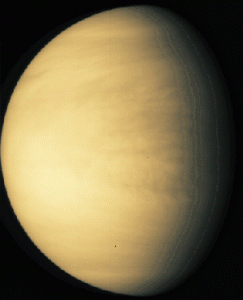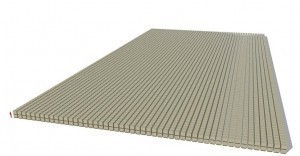What is the Size of Venus?
The size of Venus is very similar to the Earth. Its diameter is only 650 km  smaller and its mass is about 81% that of Earth. But as the facts will show, the resemblance of the two planets ends there.
smaller and its mass is about 81% that of Earth. But as the facts will show, the resemblance of the two planets ends there.
Physical Attributes
The surface area is estimated to be 4.60 × 10 sq km (to the 8th power). This is about 0.902 Earths. The volume has been calculated to be 9.38 × 1011 km3 and the mass at 4.868 5 × 1024 kg. The most
recent findings show the mean density is 5.204 g/cm3. Venus’ escape velocity is 10.46 km/s with a sidereal rotation of -243.018 day. Scientists calculate its axial tilt to be 177.3 degrees with a north pole declination of 67 degrees.
Orbital Figures
Although the size of Venus is close to Earth, the orbital figures are a bit different. The aphelion is at 108,942,109 km (0.728 231 28 AU) and the perihelion has been calculated at 107,476,259 km (0.718 432 70 AU).
The semi major axis has been determined to be 108,208,930 km (0.723 332 AU). The synodic period is 583.92 days with an orbital speed of 35.02 km/s.
Geographical Features
Nearly 80% of the planet is enfolded by volcanic plains. Nearly 70% are wrinkle edged plains. The rest of the surface is made of lobate plains and two highland continents.
One is set at the northern hemisphere; the other at the south. There are also natural formations called farra scaterred all over it. These are flat top surfaces reaching 1,000 meters high.
Although the size of Venus is well known, little is known of its internal composition. Owing to the similarity in size with the Earth, scientists believe that it has a mantle and a core.
The core could well be surrounded by hot molten liquid similar to the one on Earth. There is no internal magnetic field on Venus. Plate tectonics are also absent from the planet.
Atmosphere
The atmosphere is made up of carbon dioxide and nitrogen. It is very dense and the mass is over 90 times that of the Earth’s atmosphere. The surface pressure is 92 times more than that on Earth.
The size of Venus may make it look like Earth’s twin, but the pressure could not be more different. The pressure on Venus is equal to being 1 km deep in the Earth’s oceans.
The surface temperature is 460 C (860 F). This is possible due to the CO2 in the atmosphere, coupled with the clouds of sulfur dioxide.
Scientists have postulated several theories as to how this could have happened. Some suggested the atmosphere was originally similar to the Earth. However the water dissipated and a greenhouse effect took hold.
Magnitude
Venus is clearly visible owing to its apparent magnitude. This can range from -3.8 up to -4.6. It is so bright it is visible even at daytime.
The size of Venus made the early peoples think that it was similar to Earth. But as the facts have shown, the only similarities are in the physical dimensions. The atmosphere, geology and other features are in fact very different.





